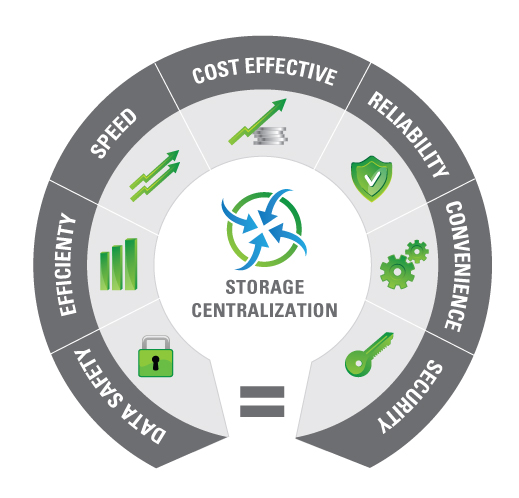Solutions for data storage management and centralization
OPEN-E DSS V7
END OF LIFE
For:
Open-E DSS V7
Data storage centralization, centralized management, and consolidation are challenges that all companies face in order to store and share data. Data storage centralization provides safety and gives users the ability to stream and download files provided by network users. The concept of centralized data management opens a variety of possibilities which are essential for any company in today's competitive and demanding market. What does this mean for the storage industry and for the evolution of storage software? Primarily, an expanded range of possibilities is changing the standard from an ordinary file server to a complex and multifunctional device.
Why storage centralization is a need
Business users are looking for safe and easy storage solutions to house exponentially increasing amounts of data. There are a few basic reasons for the growing interest in storage solutions.

Because information is the pillar of any competitive advantage, storage is of vital necessity in the modern business world. It is crucial to keep data safe using both information security and the backup process.
Centralized storage protects data, increases speed, convenience and efficiency. File sharing allows for quick and easy access to important data from almost anywhere in the world. Relative mobility and control of data can move a company workflow to a higher level of effectiveness. These advantages cannot be underestimated.
Cost is another all-important advantage of centralized data. It is possible to store and backup data on multiple machines, but it is much more logical to use central storage. Decentralized data is more cumbersome, requires time-consuming maintenance, and generates higher costs than centralized storage.
The idea of cost-effectiveness can also relate to power supplies and peripheral equipment. It is more efficient to supply a central server than to power several individual machines. The same thing applies to any peripheral equipment. It is much easier to equip a cluster than every individual machine.
Reliability is another commonly overlooked cost-cutting measure. Both modern data centers and individual centralized storage solutions are more reliable than dispersed individual machines. This single investment will ultimately prove to be more cost-effective and reliable than seemingly less expensive solutions, based on multiple distributed machines.
Hard drives are undeniably the most burdened and hard-working parts of any computer or server, and therefore no hard drive will work forever. Storage solutions help users overcome the consequences of damaged hard disks by saving data on several HDDs placed in a RAID and consolidating data on a single server.
While centralizing data in one location may seem like a security risk, data scattered on several machines increases the number of portals through which intruders can compromise your company's information. Therefore, protecting a central server is not only easier, but a more cost effective way of doing business.
These advantages provide one conclusion - storage centralization is a must. The only question remaining is how to find the best possible solution for your data management requirements.
Solutions for storage centralization
The size of your company and its individual circumstances will determine the best centralization solution for your situation. The choice is between iSCSI, NAS (Network Attached Storage), or Fibre Channel solutions.
iSCSI is the best option if there is a need to share a drive physically (and locally) for one person. Such a solution is fast and gives a guarantee of stability working within a network. It is possible to connect iSCSI to a main company Ethernet network or create a dedicated Storage Area Network (SAN), connected only to a storage array and servers.
The benefits of iSCSI include low cost, ease of use, and recent developments in the iSCSI standard. Creating and maintaining an iSCSI infrastructure is more economical and less complex to set up than Fibre Channel. New iSCSI storage arrays provide advanced data management features, including a copy of the point-in-time and synchronous mirroring. For these reasons, iSCSI is chosen mainly by small and medium enterprises.
NAS provides both storage and a file system, which is the main difference between Network Attached Storage and Storage Area Network (including i.e. iSCSI). SAN provides mostly block-based storage and leaves file system concerns on the "client" side.
The next difference between NAS and SAN is that NAS appears to the client OS (operating system) as a file server, whereas an allocated space available through SAN still appears to the client OS as a disk.
Despite their differences, SAN and NAS are not mutually exclusive, and may be combined as a SAN-NAS hybrid, offering both file-level protocols (NAS) and block-level protocols (SAN) from the same system. It gives a wide range of possibilities, from an ordinary file sharing platform to an expanded area, created for work and archiving data.
Fibre Channel is a network technology used for storage networking (in Storage Area Network). FC is dedicated for large enterprises and advanced projects. It offers speed and the ability for implementation of complex solutions.
The biggest advantage of FC is its high performance and the ability to perform distant connections. Fibre Channel is also used with the most efficient HDDs. The difference between FC (2Gb/s or even 8 Gb/s) and iSCSI (1Gb/s - 10Gb/s in the most expensive option) is minimal when dealing with point-to-point connections with a bottleneck, for example a server or mass storage device. The main difference is the ability to create a fast network with a large number of switches.
Fibre Channel-based solutions are quite expensive and complex compared to iSCSI. FC also requires the installation of a second HBA controller, as well as additional drivers and managing software. These expenses make Fibre Channel unattainable for smaller companies.
What is the best choice for your company?
There is no best choice for everyone. Companies must determine their needs, possibilities, and potential budget. Users must remember that functionality within a company's individual circumstances is much more important than speed. Businesses should also consider the skill sets of existing staff members. While FC is more demanding than iSCSI, it can be very effective with proper training.
Technical issues are also important. The efficiency of an Ethernet network may determine whether an additional iSCSI package is an option.
Storage centralization requires custom solutions and Open-E DSS V7 is flexible enough to execute on your centralization needs with minimum complexity.


